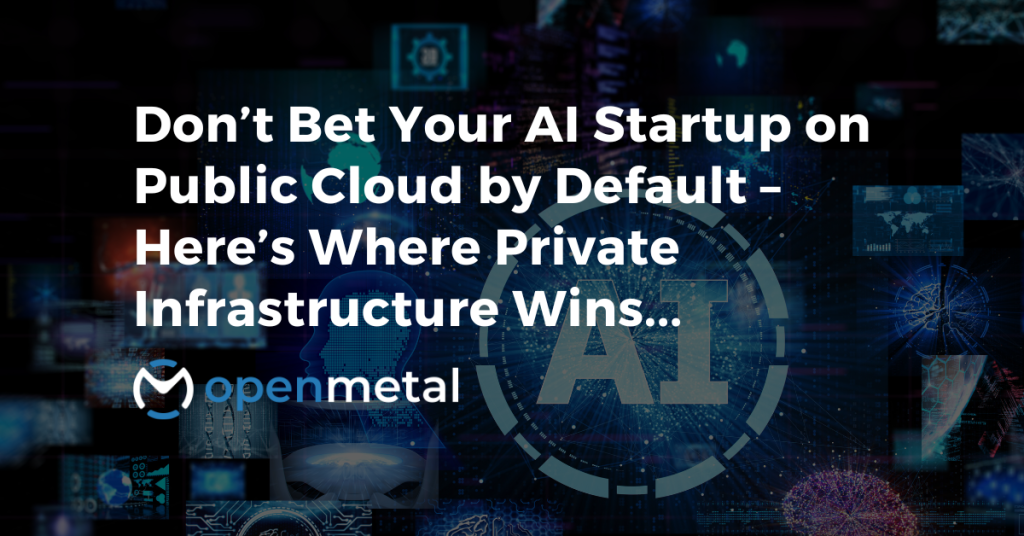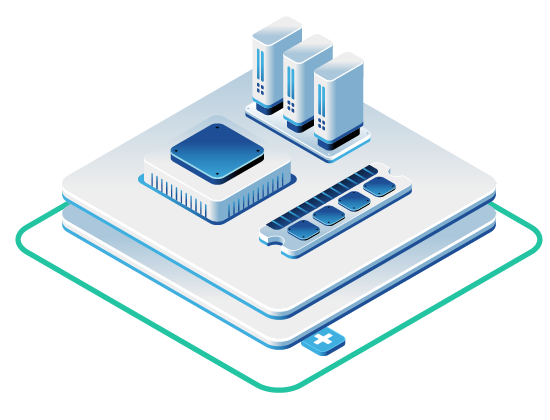
In the race to build groundbreaking AI solutions, startups often reflexively turn to the big public cloud providers for their infrastructure. The appeal is obvious – instant resources, seemingly infinite scalability, and a pay-as-you-go model that promises agility. However, in the fiercely competitive AI industry, choosing the right infrastructure early on is critical to long-term success. The wrong default can lead to skyrocketing costs, performance bottlenecks, and even stalled progress when you can least afford it.
This post makes a business case for looking beyond the public cloud status quo. In particular, we’ll explore why private AI infrastructure is a great alternative and can give AI startups a competitive edge through predictable costs, guaranteed resource availability, stronger security, direct expert support, and lower operational overhead.
The Appeal of Public Cloud – and Its Hidden Pitfalls
Public cloud platforms (AWS, Google Cloud, Azure, etc.) have lowered the barrier to entry for AI ventures. With a credit card and a few clicks, a fledgling startup can spin up GPU instances and start training models. This convenience and initial speed, however, mask several hidden pitfalls that tend to emerge as AI workloads scale from prototype to production:
Unpredictable (and Soaring) Pricing
Public clouds use usage-based pricing that can spiral out of control as AI workloads grow. Training large models or running many experiments often leads to sticker shock – especially when doing AI at scale.
As one analysis put it, “what works for traditional apps became prohibitively expensive when applied to AI workloads,” with some teams seeing bills 20× higher than anticipated (Source: InfoWorld). In short, the pay-as-you-go model can melt the budget once you move beyond trivial workloads.
A CIO speaking at a recent industry forum noted that if you try to deploy and scale real AI use cases in the public cloud, “it becomes unsustainable from a cost perspective” as usage grows (Source: The Register). Unpredictable costs make it tough for startups to plan finances and impress investors looking for a clear path to profitability.
Noisy Neighbors & Multi-Tenancy Risks
By design, public cloud infrastructure is multi-tenant – you’re sharing hardware with other customers. This can introduce the classic “noisy neighbor” problem, where another tenant’s activity on a shared server degrades your application’s performance. For AI workloads that need consistent, high throughput (especially training runs that take hours or days), these contention issues are problematic.
Public cloud GPU instances in particular “can face noisy neighbor effects”; cloud providers often time-slice or virtualize GPU hardware among users, which reduces isolation and predictability of performance. In practice, you might find training jobs slowing down or getting inconsistent results because underlying resources are throttled or contested by others.
Multi-tenancy also introduces potential security concerns – while cloud providers implement strong isolation, sharing physical hardware means a bug or vulnerability (however rare) could expose data across tenants, a risk some regulated clients aren’t willing to take. At the very least, the shared-hardware model means you never truly control the infrastructure your AI is running on.
Compliance and Data Sovereignty Barriers
Many AI startups work with sensitive data – whether it’s personal user information, healthcare records, financial data, or proprietary datasets. Using a multi-tenant public cloud can complicate compliance with regulations like GDPR, HIPAA, or industry-specific standards. Data residency requirements might restrict where data can be stored and processed, which is tough if your cloud region options are limited. Additionally, some organizations (and their enterprise customers) simply have policies against sharing infrastructure due to risk tolerance.
Public clouds operate on a shared responsibility model, which still requires you to trust the provider’s processes for isolation and security. In highly regulated industries, that may not be enough. It’s telling that sectors such as healthcare and finance – which demand strict data locality and control – are gravitating toward private infrastructure for AI. Multi-tenancy also means less direct oversight of who has access to the underlying hardware. In contrast, a private cloud allows an AI startup to know exactly where their data lives and who manages the machines, easing compliance audits and client concerns about data sovereignty.
In short, while public cloud platforms offer a quick start, their one-size-fits-all, multi-tenant approach can clash with the demanding and specialized nature of AI workloads. Startups scaling AI models have found themselves hitting unexpected walls in cost, performance, and governance. As industry expert David Linthicum observed, there is a “fundamental misalignment between how public clouds are built and what AI workloads need.” (Source: InfoWorld) Recognizing these hidden pitfalls is the first step. Next, let’s look at how a private cloud model addresses these challenges head-on.
The Competitive Edge of Private AI Infrastructure
If public cloud’s weaknesses are becoming the Achilles’ heel for AI startups, what’s the alternative? Private AI infrastructure – in the form of single-tenant clouds or dedicated servers – is emerging as a compelling solution. Providers like OpenMetal have pioneered on-demand private infrastructure as a service where startups can get a fully isolated hosted cloud (powered by open source platforms like OpenStack) or bare metal on hardware dedicated entirely to them. Essentially, you get your own dedicated infrastructure – but without the downsides of sharing resources with others. This model can be transformative for a startup’s trajectory. Here are key advantages of private infrastructure, and how they directly tackle the public cloud pitfalls:
Predictable Costs and Better Economics
For any startup, managing burn rate is a matter of survival. Private infrastructure offers far more predictable, and often lower, costs for heavy AI workloads. Rather than opaque per-second billing and surprise charges (like data egress fees) on public clouds, a private cloud arrangement typically comes with transparent, fixed pricing. For example, OpenMetal’s approach is to provide flat monthly rates for their hardware, with “no surprise bills” and even fixed or no-cost data egress in many cases. You set your hardware budget upfront and you know what you’ll pay each month – a CFO’s dream compared to the wild variability of public cloud invoices.
Importantly, the unit economics of private infrastructure improve as you scale, which aligns with a startup’s growth. While public cloud costs tend to scale linearly (or worse) with usage, owning or leasing dedicated hardware means the cost per GPU-hour or per training run drops over time. The reason is simple: you’re not paying the cloud provider’s premium on every instance-hour or the hidden cost of idle but reserved capacity. As OpenMetal notes, when you lease all the resources of the hardware (not just virtual slices), you can utilize them fully – any capacity your VMs don’t use at a given moment is “dynamically returned to you for your other VMs” rather than being billed as “wasted” headroom. The bottom line: private cloud turns your infrastructure expense into your competitive advantage, letting you do more AI compute for the same budget. And with predictable flat rates, you won’t be ambushed by a bill that drains your runway.
Guaranteed Performance (No More Noisy Neighbors)
In a private cloud setup, all hardware resources are yours alone, which means no contention, no neighbors – noisy or otherwise – and no hypervisor throttling beyond what you control. Your GPU servers run on bare-metal performance, delivering every ounce of capability to your workloads. OpenMetal’s GPU clusters, for instance, run with “no virtualization layer” at all, giving customers full control of their hardware . The difference in performance consistency is dramatic. Applications see predictable throughput and latency, with none of the jitter that comes from shared environments. For an AI startup, this reliable performance translates to faster training iterations and more confidence in meeting SLAs for inference latency.
Crucially, private infrastructure eliminates the “shared resource unpredictability” that plagues public cloud GPU instances. There’s no cloud scheduler deciding to time-slice your GPU or limit its clock speed because another customer is using the same host. As a result, you can fully exploit the hardware’s capabilities – whether it’s running multi-GPU distributed training or fine-tuning models with guaranteed throughput. This consistency can be the difference between hitting your development milestones or endlessly debugging performance issues that were actually caused by external interference. In summary, private cloud ensures that when you need performance, you get performance, every single time. Your only “neighbor” on the hardware is your own workload.
Control, Security and Data Sovereignty
Private AI infrastructure delivers a level of control and security that no public shared model can match. Because you are the sole tenant, all data remains within your private environment – a critical point for regulated industries or any startup dealing with sensitive data. You can implement your own stringent security measures (encryption, access controls, monitoring) on top of the base infrastructure, and you have the assurance that no other entity is running code on the same machines. This isolation is a strong guard against risks like side-channel attacks or accidental data leakage across tenants. It also simplifies compliance: hosting patient data on a single-tenant environment, for example, makes HIPAA or GDPR compliance checks more straightforward as you can definitively demonstrate data segregation.
Data sovereignty concerns are also easier to address. Need to ensure all data and computation stay in a specific country or facility? With OpenMetal private cloud, you can choose the Tier II data center location that aligns with your governance needs. You’re not at the mercy of a public cloud’s region availability or policies that might move data for redundancy. This level of control is why providers like OpenMetal see uptake in sectors where data locality and compliance are particularly important, including healthcare, finance, and research. Even in less regulated sectors like nonprofits, organizations are increasingly prioritizing data protection to build and retain donor trust. This includes implementing strong encryption, secure payment processing, and adherence to global security standards to ensure the safety of sensitive donor information. Pairing these safety measures with fencing off your proprietary training data and models in your own cloud can provide peace of mind – and a stronger story for your customers about how you protect their data.
Beyond data security, having control over the infrastructure means you can optimize it for your specific AI needs. Want to enable a specialized NVIDIA GPU feature or tune the networking for faster multi-node training? On a public cloud you might be stuck with default settings, but on a private cloud you have root access to configure hardware and software as needed. This level of customization can yield performance boosts and capabilities (like custom GPU partitioning, special drivers, etc.) that set your AI platform apart. In essence, private infrastructure lets you tailor the environment to your workload, rather than contorting your workload to fit the public cloud’s limitations.
Access to Expert Support and Lower Operational Overhead
A common misconception is that running your own infrastructure means hiring a huge DevOps team and diverting focus from product development. In reality, modern private cloud offerings come with robust managed services and support that can actually reduce operational overhead for startups. With the right partner, you’re not racking and stacking servers yourself – the provider delivers the hardware fully automated and manages the underlying platform, while you simply deploy your AI applications on it. For example, OpenMetal can deploy a private cloud in as little as 45 seconds for immediate use, and offers managed support tiers where their cloud engineers help oversee the environment. This means a small startup team can enjoy a dedicated infrastructure without needing in-house experts for every layer – you gain direct access to the provider’s engineering expertise. If an issue arises in your cluster or you need to optimize something, you have experienced cloud engineers on call who know the system intimately. It’s a very different experience from being one customer among millions in a public cloud, where support is often a generic knowledge base or a slow support ticket queue.
The level of personal guidance can be a game-changer. Some of OpenMetal’s private cloud users describe the relationship as if the provider’s engineers became an extension of their own team . For an AI startup, this means you can focus on model development and product features, rather than fighting with cloud quotas or mysterious performance issues. Operational overhead drops because many routine infrastructure tasks (patching hypervisors, replacing failed drives, monitoring hardware health) are handled by the private cloud provider. At the same time, you avoid the overhead of constantly optimizing for cost – there’s no need to micro-manage instance lifecycles or chase spot instances to save a buck, since your costs are fixed and lower to begin with. In short, private infrastructure paired with managed services gives you the best of both worlds: the control and exclusivity of owning your environment, with the convenience of expert support akin to having an outsourced ops team. This enables even small startups to leverage sophisticated infrastructure without sinking resources into IT management.
Long-Term Strategic Scalability
Finally, choosing private infrastructure early can set up your startup for smoother long-term scaling. Today it might be a few GPUs for R&D, but if your product takes off, you may need to scale to dozens or hundreds of GPUs delivering AI services globally. With public cloud, scaling often means exponentially increasing costs and potential re-architecture to avoid those costs. By contrast, if you start with a private AI infrastructure provider like OpenMetal, you can grow it by adding more nodes or clusters in a predictable way. There’s no sudden price cliff when you go from 10 servers to 100 – in fact, volume often brings cost benefits. Moreover, you avoid painful migrations later; many startups eventually realize they have to repatriate workloads from public cloud to private infrastructure to regain control of costs or performance. Those transitions (often under time pressure) can be technically fraught. By choosing the right infrastructure from the outset, you sidestep that disruption. Your team builds expertise on a platform that will serve you from MVP stage to scale-up stage. In the context of the AI arms race, this stability and foresight is a strategic advantage. It means infrastructure will be an enabler of your growth, not a bottleneck or budgetary black hole.
Conclusion: Building a Foundation for Long-Term AI Success
The decision of where to run your AI workloads is not just a technical one, but a strategic business decision. In the early days of a startup, it’s tempting to grab whatever resources are easiest to launch your prototype – and public clouds certainly make it easy to get started. But as we’ve explored, defaulting to the public cloud can introduce serious risks and inefficiencies that manifest just as your AI startup is trying to scale or distinguish itself in the market. Unpredictable costs can drain your finances; performance hiccups and resource delays can slow your pace of innovation; and security or compliance limitations can shut you out of lucrative opportunities. In a field as competitive as AI, these hurdles can be the difference between leading the pack or falling behind.
On the other hand, investing in a private AI infrastructure strategy (for example, leveraging OpenMetal’s private IaaS platform) from the beginning can set your startup on a more stable, sustainable trajectory. You gain clarity in costs, confidence in performance, and control over your most critical assets – your data and your compute. This is not about spending more on infrastructure for its own sake; it’s about spending smarter to enable faster development and better outcomes. The advantages of predictable budgeting, guaranteed resources, and expert support free you to focus on what truly differentiates your business: your AI models, your product features, and your customers.
Ultimately, choosing private infrastructure early is about being deliberate with the foundation of your company. Just as you carefully hire talent and craft your IP, you should carefully choose the technology bedrock that will support everything you build. The right infrastructure choice will scale with you, not surprise you with new problems at scale. It will amplify your strengths (speed, innovation) and mitigate your risks (cost overruns, downtimes, compliance issues). In the fast-moving AI landscape, startups need every edge to succeed – and infrastructure is a big one.
In conclusion, don’t simply follow the crowd to the public cloud. As we’ve argued, there are compelling business reasons to consider a private cloud approach for AI from day one. The startups that recognize this early will have the advantage of stronger foundations and fewer growing pains on the road to success. In the quest to build the next AI unicorn, making a savvy infrastructure choice now could save you from pain later – and just might accelerate your journey to the top. Your GPUs, your data, your budget – they all perform better when they’re under your control. Make infrastructure an enabler of your vision, not a hurdle, by thinking twice about the cloud and giving private AI infrastructure the serious consideration it deserves. Your future self (and your CFO) will thank you.
Interested in Private GPU Servers and Clusters
for your AI Startup?
GPU Server Pricing
High-performance GPU hardware with detailed specs and transparent pricing.
Schedule a Consultation
Let’s discuss your GPU or AI needs and tailor a solution that fits your goals.
Private AI Labs
$50k in credits to accelerate your AI project in a secure, private environment.


































